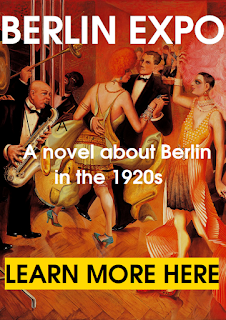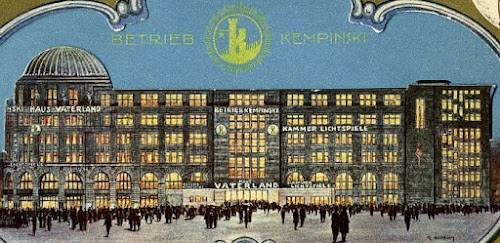 |
| Alex as Alfred Döblin may have known it. Around 1920. |
Alexanderplatz, or Alex, as Berliners often name it, is, along with Kurfürstendamm the most emblematic name among streets and squares. Alex, in the eastern part of the city, was and is an important transport hub, like Potsdamer Platz, more to the west. But besides, it is the novel by Alfred Döblin, from 1929, filmed several times, which made Alex known even outside Germany's borders.
As a hub, Alex is the eastern counterpart to Potsdamer Platz. Neither is a planned square, like Pariser Platz or Leipziger Platz. They emerged as a result of different factors and their shape wasn’t clear-cut and regular.
Alex has experienced dramatical changes during its history. If you look at pictures from 1900, you will hardly recognize the place. The two famous buildings, Alexanderhaus and Berolina Haus, were not yet there, nor was the U-Bahn station. Around 1930 the two "Haus" by the architect Peter Behrens emerged from the ground underlining clearly the south-eastern border of the square. They were miraculously spared by the allied bombings in WWII, and they resisted the drastic planning of the GDR-urbanists. But the rest is gone. When the remodeling of Alex by the East Germans planner was ready, around 1960-70, what had been a square was a vast empty area of 3 ha, bordered by the above mentioned Behrens’ buildings and by some anonymous newly produced skyscrapers.
After the reunification in 1989, the empty space was filled with new, not especially graceful buildings, among others the Kaufhof department store at the very place were another big store, Hermann Tietz, had stood before the war. Those new buildings have still the merit of making the place smaller, not exactly cozy but at least a space easier to apprehend, to grasp. Comparing today’s Alex with old photographs, not much is recognized. But if you look at it from the north-east angle, focusing on the south-western part, it doesn’t differ that much from its look in, say, 1932, thanks to the two massive survivors (Berolinahaus and Alexanderhaus), to the S-Bahn viaduct, with the elevated railroad station’s glass roof and steel structure and to the red tower of the Town Hall in the background. You'll need of course to disregard the TV-tower. When the people behind the TV-series Babylon Berlin shot scenes here, they recreated (with digital means) the defunct red building of the police headquarters (Rote Burg), they replaced the advertisements and put in an old tram. The reconstruction was quite satisfying, I feel.
 |
| Around 1935. Compare with the pic below. |
 |
| From "Babylon Berlin", with the red police headquarters to the left |
It
is important to note that the famous TV-tower, pride of GDR’s Berlin,
is not IN the square but some 200 meters to the south-west. The same
goes for the train station, which appears in most pictures: it is
outside Alexanderplatz proper, but very close to it.
From the
beginning, Alexanderplatz was just an empty space between different
quarters. "No planned square defined by the structures bordering it,
more a left-over space, one which simply grew out of the coming together
of various arbitrary patterns of movement and housing development".
(Martin Kieren in Alexanderplatz, Städtebaulicher Ideenwettbewerb)
Then
came the transports : the horse-drawn buses replaced by electric
powered tramways in 1898, the underground in 1913 and soon amounting to
three lines, and the suburban train S-Bahn. All those lines, irradiating
in all directions, granted the square its status of traffic-hub. It is
worth to note that the S-Bahn was not just the original circle line from the end of the XIX century which went in a ring around inner Berlin; several lines were added in time to the network, which connected
important points of the inner city as well, Alexanderplatz among others.




















